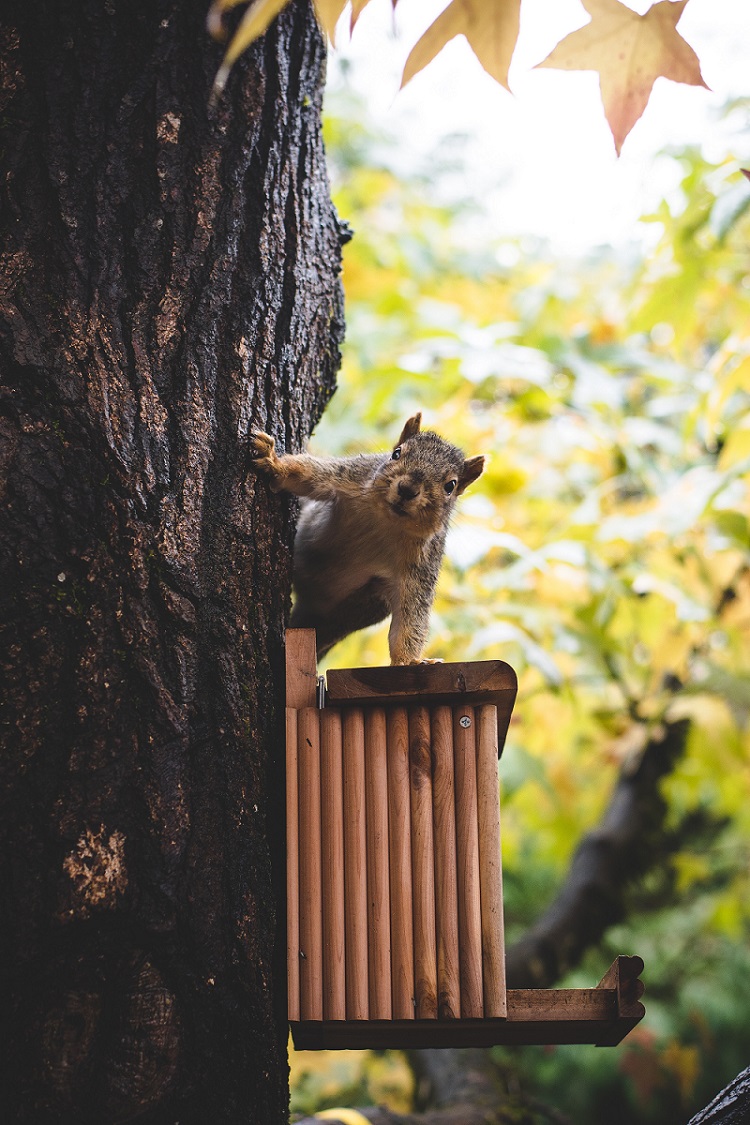Squirrels

What is a squirrel?
There are over 200 different species of squirrels in the United States. The squirrel family includes ground squirrels, tree squirrels, chipmunks, marmots, prairie dogs, and even flying squirrels.
As their names imply, tree squirrels live in forested areas, while ground squirrels burrow underground; ground squirrels also hold the distinction of being the only type of squirrel that will hibernate in the winter.
Flying squirrels live in holes in trees or build nests in the crooks of tree branches. Flying squirrels might be more appropriately called “gliding squirrels,” because they are incapable of true, powered flight. Instead, flying squirrels merely glide through the air via flaps of skin between their front and back paws. The longest “flight” of a flying squirrel ever recorded was 200 feet—pretty good for something that can’t fly!
Squirrels are typically active all day, especially in the fall and spring months when they are more spirited in their search for food. Interestingly, while both red and grey squirrels (both tree squirrels) are diurnal—meaning they are active during the day—it has been observed that reds typically emerge about 30 minutes after sunrise, while grey squirrels may be active prior to dawn. Ground squirrels are also active during the day, usually from midmorning to late afternoon, while flying squirrels are nocturnal. Squirrels, in general, are highly adapted to human environments, so much so that you might see them darting around your yard every day, especially if you live in a highly wooded area.
What does a squirrel look like?
Squirrels are bushy tailed rodents, rather small, with relatively lean bodies and large, dark eyes. Their hair is generally short and silky, but it varies in thickness and color from species to species.
The two most common squirrel species in the US are the eastern gray squirrel and the red squirrel, the colors of which are hardly a matter of debate. But not all US squirrels are either gray or red. The Douglas squirrel, for example, is grayish in color with a chestnut-colored belly, and the thirteen-lined ground squirrel—a resident of the central US and Canada—has a distinctive brown coat that sports both spots and stripes.
As far as physical size is concerned, the smallest squirrel in North America is the flying squirrel, clocking in at a diminutive 4.9 ounces, while the largest is the fox squirrel, which weighs anywhere from 1 to 3 pounds. The eastern gray squirrel, the most prevalent squirrel on the continent, weighs about a pound on average. Possibly the largest squirrel in the world is, rather unexpectedly, a flying squirrel—the western woolly flying squirrel. It lives on the slopes of the Himalayas and is one of the largest gliding animals known—they can surpass 45 inches in length (including the tail) and weigh over five pounds!

What does a squirrel eat?
Squirrels have never been accused of being picky eaters. They are omnivores, so in addition to their well-documented love of nuts, they will also eat fungi, nuts, bark, sap, seeds, fruits, insects, and even the occasional small snake. Squirrels are so indiscriminate with their diet, in fact, that they will eat pretty much anything, which is partly why they are widely considered to be pests. They are not above raiding your bird feeders or digging into pet food that is improperly stored outside. When preparing for winter, squirrels will begin burying their food, so they will have an ample supply when food becomes scarce. Sometimes squirrels will forget about the stockpiles they’ve made, and the nuts—especially acorns, which are the seeds of oak trees—will grow into a tree. So next time you see an oak tree (or any tree, really, for that matter), you might ponder if it owes its existence to the forgetfulness of a squirrel.

Where do squirrels live?
Squirrels live in almost every habitat, from tropical rainforests to semiarid deserts, avoiding only the high polar regions and very dry deserts. They are found all throughout the United States, although some squirrel species are exclusive to a particular region. For example, eastern gray squirrels are found only in the eastern US, and the red squirrel is found from the tree line of North America south into the northern U.S., the Northeast, and continuing into the Rocky and Appalachian Mountains. Squirrels thrive in mature or nearly mature forests and are particularly attracted to land with at least 50 to 75 nut and shelter trees, such as oak, hickory, walnut, pecan, elm, and maple trees. They have integrated themselves into human environments very successfully, and are a very common sight in urban and semiurban areas.

When are squirrels born?
For squirrels, the period of courtship that precedes copulation is relatively brief and unritualized. One to 10 males may approach a female during her single-day estrus period, with a dominant male eventually approaching her while giving quiet vocalizations, then mounting her. Copulation is rather brief, and it may occur several times before the female eventually becomes aggressive. After a gestation period that lasts around 40 days, the female gives birth to her young in a nest that is generally made of bark and shredded leaves.
A typical litter generally contains 3-5 young, but can vary from 1-8. The young are blind and naked at birth, and develop slowly—they do not even open their eyes until they are at least 27 days old. By day 30, they are fully furred, and begin to venture from the nest. They are weaned soon after. Sexual maturation for squirrels occurs the winter after their birth.
How to Live Harmoniously with Squirrels
Squirrels, like pigeons and other fauna, are synanthropes, meaning that they thrive from their interaction with human environments. This process of successful interaction is known as synurbanization, and it results in the squirrels losing much of their inherent fear of humans in a human environment. This fascinating transformation should be apparent to anyone living in the United States, where squirrels will often brazenly come up onto one’s porch in search of food—this is when squirrels can cross the line from charming fauna to pest.
Living harmoniously with squirrels, then, means making some habitat modifications that benefit them, while also excluding them from your house entirely. Perhaps the most meaningful gesture you can make might also be the simplest: offering them food and water. Place squirrel feed (or nuts, or fruits, or cracked corn) in a shallow dish on the ground or on a raised area like a tree stump. For water, get a bird bath or a shallow water dish and keep it well stocked at all times. The local squirrel population will thank you, even if they won’t be able to do so directly.
Frequently Asked Questions
The most common varieties of squirrels in the U.S. are:
- Gray squirrels – The largest of the common squirrel species, gray squirrels reach about 20 inches long. They are the most widely distributed type nationally.
- Fox squirrels – Often found in spacious states like Texas and Colorado, these animals prefer open, sunlit ground with plenty of room for foraging and nesting.
- Black squirrels – This squirrel species is the result of gray and fox squirrels mating. Their dark fur retains more heat, helping them nest in colder areas.
- Flying squirrels – These secretive animals rarely come into contact with humans. They are smaller than most other types of squirrels, measuring only about 12 inches long, and have a special skin membrane that helps them glide from tree to tree.
Finding droppings under bird feeders or on attic floors could be a good indicator that squirrels are present. However, telling their waste apart from that of other pests, such as rats or mice, can be difficult. To differentiate squirrel droppings from other pest feces, closely examine their size, shape, and color. Squirrels leave behind cylindrical, segmented waste pellets around half an inch in length. They are typically black, but can also be brown or even red in color.
Female squirrels usually give birth to two litters a year, each containing an average of two to three pups. Young are born without fur and aren’t ready to leave the nest for at least a month and a half. By the time two months pass, baby squirrels are typically weaned and on their own.
Typically, about half the squirrels in a population die each year. Predators like hawks, owls, coyotes, bobcats, and snakes eat squirrels. Parasites, diseases, and falls can kill squirrels. Human interactions like car collisions also threaten squirrels.
Eastern Gray Squirrel Life Expectancy
At birth, the gray squirrel’s life expectancy is only two years. In the wild, the maximum recorded life span for gray squirrels is 12 years. In captivity, squirrels can live up to 20 years.
Red Squirrel Life Expectancy
The average red squirrel lives five years, though the pests have great difficulty surviving their first year. 9 years is the longest recorded wild red squirrel lifespan.
Ground Squirrel Life Expectancy
The average lifespan for the California ground squirrel is 3 to 4 years in the wild, but they can live as long as 6 years. In captivity, the recorded lifespan for the ground squirrel is 10 years.
Squirrels spend most of their lives in trees, but they do have to come down to look for food. As a result, property owners are sometimes able to gauge the presence of the pests by looking for their footprints. Squirrel tracks have four toes on the front feet and five toes on the rear feet, though size can vary widely. On the small side, front footprints are one and a quarter inches long by three-quarters of an inch wide and rear tracks are one and a quarter inches long by one inch wide. Front and rear tracks can top out at approximately two inches long and wide.
Squirrel tracks are most commonly confused with those of rabbits. The crucial difference is that squirrel tracks will run straight toward trees, where rabbits go around them. Also, squirrels are erratic in their travels, so large gaps can exist between tracks. Rabbits are much more consistent, with roughly 20 inches between each set of prints. All four squirrel tracks in dirt may appear nearly side-by-side due to the animals’ galloping gait, in which the hind feet land slightly in front of where the front feet were planted. A track might also show evidence of the tail dragging across it.
Most people know that rats are members of the rodent family, though few realize that rats and squirrels are closely related. In fact, rats and squirrels have a number of similarities:
- Both pests must constantly gnaw on wood and other items to wear down their ever-growing teeth.
- Tree squirrels are known for their bushy tails, while rat tails are notoriously scaly.
- Their diets are quite similar, as both are omnivores.
Though the two pests have similar habits as well as habitats, telling them apart is crucial to successful removal from the home.


